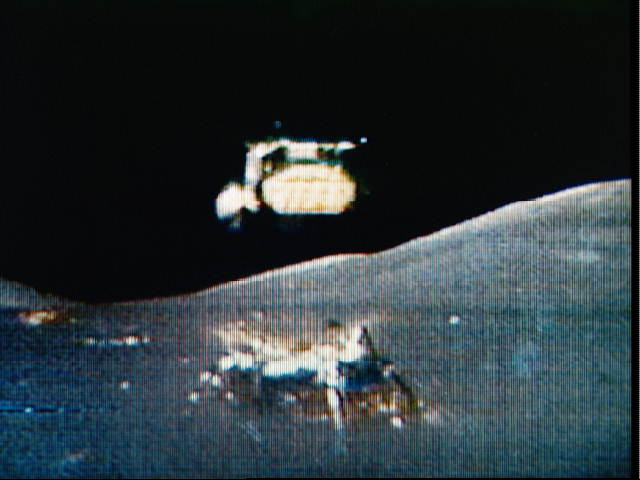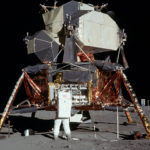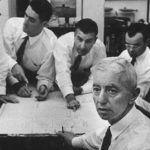The Mars Rover Sky Crane, SpaceX Self-Landing Booster, and the Apollo Lunar Lander are just a few examples of dramatic, radically unconventional thinking, leading to astounding successes.
While we now consider a lunar in-orbit rendezvous as routine, the viability, and risk of even a more-basic Earth-orbit link-up was a major concern at the time (rendezvous was so new that astronaut Buzz Aldrin’s Ph.D. thesis at MIT was on this subject (References 8 and 9). Houbolt’s proposal for a lunar-orbit rendezvous was almost inconceivable and, therefore, even more challenging. He proposed it even before any far-simpler Earth-orbit linkup had ever been tried.
No one knew if such a complex set of maneuvers was possible in basic Earth orbit; to do it around the Moon seemed nearly impossible. The reality is that orbital mechanics, navigation, and rendezvous are very difficult and unforgiving, especially with a so drastically fuel-constrained scenario.
However, as the Apollo mission’s proposed structure and design proceeded and became more tangible, and thus the equations of fuel, mass, and operational sequences became more robust, the analysis and risk for a third-stage lunar landing and liftoff showed the overall plan could not succeed. As a result, Houbolt’s radical alternative approach became the one to look at more closely and implement if its many issues could be addressed.
From an engineering perspective, what’s most noteworthy about the decision to pursue the independent, disposable Lunar Module (the ascent stage was discarded after the rendezvous with the orbiting Command Module) is how it tossed out most of the original fundamental design constraints. Instead of being the entire launch rocket’s third stage returning to Earth, the landing vehicle would only have to work in the low-gravity, no-atmosphere moon environment.
This change had a “ripple effect” through the entire Apollo project approach all way back to its basics. The design effort was restarted with a nearly blank page, as everything about the mission – from huge Saturn V first stage to the tiny landing vehicle, as well as the mission’s sequence of events – could be re-examined. The consequences to the mission architecture were dramatic:
- The lunar lander itself no longer had to survive a return to Earth, which could be an ultralight, relatively flimsy, one-time use vehicle.
- The in-orbit rendezvous technique had to be mastered and then extended for lunar-orbit rendezvous where there would be no second chance and no backup escape plan if unsuccessful.
- The lift-off engine of the ascent module that would blast the astronauts back from the surface up to rendezvous with the orbiting Command Module would have no redundancy; it would have to be extremely simple and reliable and had to work perfectly just once on that first, and only time it would be fired (Figure 1).

The story of John Houbolt is another case of a lone wolf whose radical ideas were contrary to conventional wisdom. Fortunately, he received vindication fairly early in his career rather than at the end of his life (or after his passing), Reference 10. In the end, he won out: the analysis and physics eventually confirmed that his “crazy” idea was the only one that had a chance of succeeding — which it did.
EE World Related Content
- Engineering the atomic submarine, Part 1: One man’s audacity, determination, dedication revolutionized naval reality
- Engineering the atomic submarine, Part 2: One man’s audacity, determination, dedication revolutionized naval reality
- The first undersea transatlantic cable: An audacious project that (eventually) succeeded, Part 1
- The first undersea transatlantic cable: An audacious project that (eventually) succeeded, Part 2
- The Ocean Liner S.S. United States: Part 1 – An audacious concept
- The Ocean Liner S.S. United States: Part 2 – A radical design
- The Ocean Liner S.S. United States: Part 3 – Rapid obsolescence
- The Ocean Liner SS United States: Part 4 – The cruise ship as successor
External References
- Murray Cox & Catherine Cox Bly, “Apollo: The Race to the Moon”
- “SpaceX Lands All 3 Falcon Heavy Boosters for the First Time” (video)
- “How SpaceX Lands Rockets with Astonishing Accuracy” (video) (around 5:45 for schematic)
- SpaceX, “Falcon Heavy”
- NASA, “The Rendezvous That Was Almost Missed: Lunar Orbit Rendezvous and the Apollo Program”
- NASA, “Enchanted Rendezvous: The Lunar-Orbit Rendezvous Concept”
- Space Stack Exchange, “Text of John Houbolt’s letter proposing Lunar Orbit Rendezvous for Apollo?”
- MIT, Buzz Aldrin, “Line-Of-Sight Guidance Techniques For Manned Orbital Rendezvous“
- Buzz Aldrin, “Orbital Rendezvous“
- NASA, “John C. Houbolt, Unsung Hero of the Apollo Program, Dies at Age 95”
- Adam Steltzner and William Patrick “The Right Kind of Crazy: A True Story of Teamwork, Leadership, and High-Stakes Innovation”






